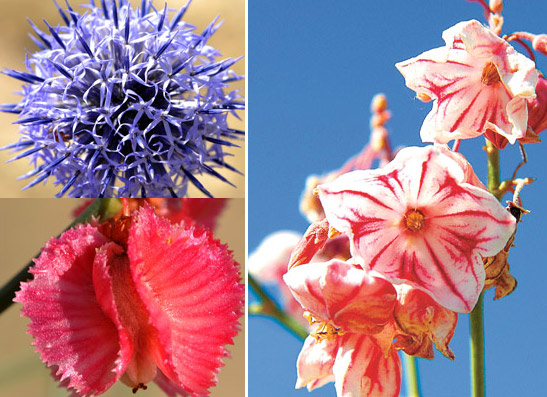

Since 2003, 20 million drought-enduring plants, including (clockwise from top left) Echinops sphaerocephalus, Poacyngrn hendersonii and Calligonum rubicundum, have been planted along the road. Photos by Hou Yiguo / for Chind Daily
However, in a desert that has annual precipitation of just 10 millimeters, "planting a tree and nurturing it to full growth is even more difficult than raising a child", Xu said.
Xu found seeds and plants that can survive in the bitter salt water under the sand, such as Chinese tamarisk, calligonum and Haloxylon ammodendron.
Since 2003, 20 million drought-enduring plants have been planted along the road, forming a 72-to 78- meter green belt.
The plants are irrigated by underground water pumped up 114 water wells. Compared to the cost of maintaining fences and barriers, irrigating the plants save some 30 million yuan ($4.9 million) every year.
The discoveries and applications of the desert plants is a lengthy process, according to Guan Kaiyun, director of the Turpan Eremophytes Botanic Garden.
"Our researchers working in the stations find the plants and seeds, and we are in charge of plant introduction and acclimatization, which sometimes takes more than a decade to finish," Guan said.
In the parched Turpan Basin sits the world's only botanic garden of Asian desert flora. When a new plant is found, the samples are usually taken back to the garden, where scientists find ways to help the plants adapt to the new environment.
Spending four decades introducing and preserving desert plants, the botanic garden now has 700 different species, 50 of them endangered. Estimates put the number of plant species in the desert at about 5,000.
The plants also provide scientists with research opportunities.
One example Guan gives is Ammopiptanthus nanus, an endangered evergreen shrub in Xinjiang on which scientists recently extracted a protein that can combat deep cold.
"That protein explains the reason that Ammopiptanthus nanus survives the extreme low temperatures. And it's worth further study because we might use it in genetically modified techniques in the future," Guan said.
Tian Changyan, deputy director of the Xinjiang Institute of Ecology and Geography, has devoted 10 years to finding the perfect plants that could improve the saline-alkali soil.
"Some plants can only grow in excessively saline soil. If we cultivate these plants on moderately saline soil, the plants will extract the salt out of the soil and improve its fertility," Tian said.
From 305 different salt-tolerant species, Tian identified six that were the most efficient. Experiments on a 67-hectare test field showed the plants were able to reduce the soil salt from 3 percent to less than 0.6 percent within three years.
"Compared to the old method of washing the saline soil with water, the plants are much more effective and sustainable," Tian said.
Scientists at the Xinjiang Institute of Ecology and Geography have devised a major project which could change the landscape forever. By 2020, the institute will build a gene bank of arid regional plants covering 10,000 plant species. Also, a world-class botanical garden is planned for Ili Kazak autonomous prefecture.
"The arid regional plants have excellent genetic features, so the genes are a significant strategic resource of the country," Guan said.
"The genes have great potential for our future development of agriculture, medicine and the military."
Pressure mounts over arable land resources
2012-12-26Keep a red line for arable land
2012-03-05President Hu stresses arable land protection
2011-08-24Copyright ©1999-2018
Chinanews.com. All rights reserved.
Reproduction in whole or in part without permission is prohibited.